Grand Junction Field Office – Community Forestry
The Grand Junction Field Office’s Community Forestry Program provides technical assistance to Western Colorado communities.
Quick Links
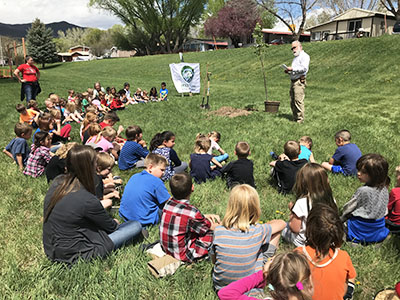 Tree City USA
Tree City USA- Recommended Tree List for Western Colorado
- Champion Tree Program
- Street and Park Tree Inventory
- Tree and Shrub Pruning
- Tree and Shrub Planting
- Community Forestry Links
Caring for our trees not only protects our investment, but provides benefits for the future. People often choose community trees for their beauty and ability to provide shade. Trees benefit communities by providing urban forests that many times include social attachment to individual trees. They also improve air quality, control erosion, moderate the sun’s effects and attract wildlife.
Key components of our Community Forestry Program include:
- Helping organize and support local tree boards
- Conduct street and park tree inventories
- Conduct Insect and Disease assessments
- Assist with tree planting and tree care needs
- Technical assistance on how to plant and maintain trees
- Provides information and workshops on tree care
Tree City USA
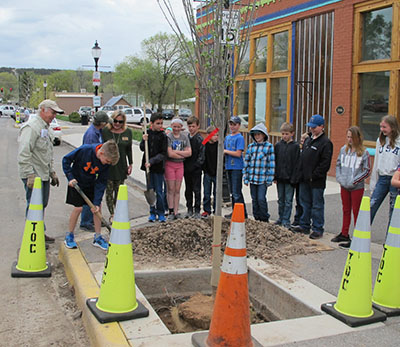 The National Arbor Day Foundation (NADF) encourages tree planting and environmental stewardship through educational programs. Two NADF programs that the Grand Junction Field Office is quite involved with are Tree City USA and Arbor Day celebrations. For a community to become a Tree City USA, four requirements must be met to receive this honor:
The National Arbor Day Foundation (NADF) encourages tree planting and environmental stewardship through educational programs. Two NADF programs that the Grand Junction Field Office is quite involved with are Tree City USA and Arbor Day celebrations. For a community to become a Tree City USA, four requirements must be met to receive this honor:
- Have a tree board or city department that is responsible for the trees
- A tree care ordinance
- A community forestry program with an annual budget of at least $2 per capita
- An Arbor Day observance and proclamation
If your community is interested in becoming a Tree City USA, please contact the Grand Junction Field Office.
Several Western Slope communities are proud Tree City USA members
| Community | Years | Population | |
|---|---|---|---|
| Aspen | 29 | 7,500 | 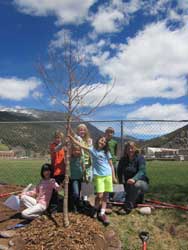
Basalt’s first Arbor Day |
| Basalt | 10 | 4,160 | |
| Carbondale | 27 | 6,900 | |
| Cedaredge | 27 | 2,300 | |
| Fruita | 28 | 13,400 | |
| Glenwood Springs | 36 | 10,000 | |
| Grand Junction | 38 | 63,400 | |
| New Castle | 17 | 4,500 | |
| Paonia | 14 | 1,480 | |
| Silt | 23 | 3,100 |
Recommended Tree List for Western Colorado
Proper tree selection is important when replacing or adding trees to your urban forest. A tree’s shape, characteristics, growth rate and size at maturity should be considered when choosing a location for it.
Different species of trees are recommended depending on where you live in Western Colorado and how much water you can provide.
- Do you live in the Grand Valley or at low elevation? Read Tree and Shrub Guide (880 KB PDF)
- Do you live the Mountains? Read Trees and Shrubs for Mountain Areas (4.4 MB PDF)
- Do you only want to plant native shrubs and trees? Read Native Shrubs for Colorado Landscapes (5.4 MB PDF) and Native Trees for Colorado Landscapes (4.6 MB PDF)
- Is water a big concern? Plant drought tolerant and xeriscape plants. Read Drought-Tolerant Trees for Colorado Landscapes (208 KB PDF) and Xeriscaping: Trees and Shrubs (711 KB PDF)
Champion Tree Program
American Forests maintains a national registry of the largest trees in the nation. The Colorado Tree Coalition (CTC) administers the Champion Tree Program in Colorado and the CSFS assists the CTC by measuring potential champions, publicizing the program and educating Coloradoans about our “champion” trees.
If you think that you have a potential champion, please contact the Grand Junction Field Office.
Where are Current Champion Trees Located in Western Colorado?
- Delta County (84 KB PDF)
- Garfield County (98 KB PDF)
- Mesa County (113 KB PDF)
- Pitkin County (76 KB PDF)
- Rio Blanco County (78 KB PDF)
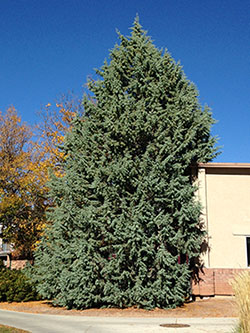 |
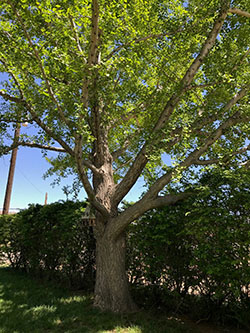 |
 |
| The State Champion Arizona Cypress is growing on the Colorado Mesa University campus in Grand Junction. | The State Champion Ginkgo is in Palisade. | The State Champion London Plane is in Grand Junction. |
Street and Park Tree Inventory
A tree inventory of the community’s public trees is often the first step toward effectively managing the community forest. A tree inventory can be very useful to the community, as it will identify tree species, hazardous trees, pruning needs, insect problems, incidence of disease and open spaces available for tree planting. The inventory is an integral part of any long-range plan to sustain the urban forest.
The Grand Junction Field Office can conduct full street and park tree inventories for local communities and subdivisions. Our inventories are based in the Geographical Information System (GIS) software ArcGIS that is used to locate and pinpoint right-of-way trees on aerial photos and then attach tree data to the tree point.
Any communities interested in developing a tree inventory or have the CSFS conduct a tree inventory, contact the Grand Junction Field Office.
To see an example of a completed tree inventory, view the town of Carbondale map (324 KB PDF). This map shows all the trees inventoried, the data collected on each tree is housed in the ArcGIS software program. The River Valley Ranch Master Association located in Carbondale also recently completed an inventory. View the River Valley Ranch Master Association map (431 KB PDF).
Tree and Shrub Pruning
Urban trees and shrubs require pruning to help make them strong and healthy and to prevent any damage during strong storms.
The following information can help the landowner make the right choices and use the proper techniques when it comes to taking care of the plants in our landscapes.
- For general information on why it is important to prune, what type of tree to buy (container vs. ball and burlap), and how to select an arborist to prune your tree
- Why Pruning Trees is Important (1.6 MB PDF)
- What Type of Tree to Buy (500 KB PDF)
- How to Select the Right Arborist (3 MB PDF)
- Why Pruning Trees is Important (1.6 MB PDF)
- For information on the different types of pruning techniques and how to properly prune
- The Different Types of Pruning (500 KB PDF)
- How to Properly Prune a Tree (2.4 MB PDF)
- When and Where to Prune a Tree (2.1 MB PDF)
- For information on pruning evergreen trees
- How to Prune Evergreen Trees (1 MB PDF)
- For information on common flowering shrubs and their pruning needs and pruning flowering shrubs
- Common Flowering Shrubs and Their Pruning Needs (130 KB PDF)
- How to Properly Prune a Shrub (1.5 MB PDF)
- For general information on what pruning tools to use and general branch pruning (2.8 MB PDF)
- For information on pruning evergreen trees (737 KB PDF)
- For information on pruning fruit trees (1.2 MB PDF)
- For information on common flowering shrubs and their pruning needs (122 KB PDF) and pruning flowering shrubs (236 KB PDF)
Tree and Shrub Planting
You have selected your tree or shrub and the location has been chosen, now comes the planting. This is where the plant will be located for the rest of its life! It is very important to find the root flare, plant at the right depth, and remove as much of the packaging the tree came in as possible.
Following the steps in these handouts will give your tree or shrub the opportunity for a long and healthy life for your family to enjoy.
- How to Properly Plant
- How to Properly Plant Your Tree (3 MB PDF)
- Colorado Master Gardener: Tree Planting Steps (Garden Notes #636) (205 KB PDF)
Community Forestry Links
To learn more about trees in your community, please visit:

